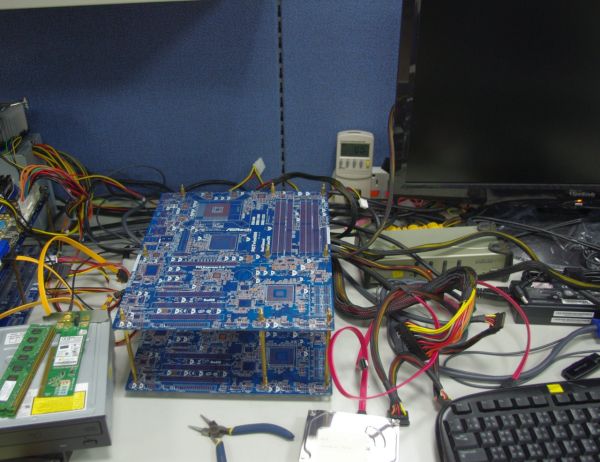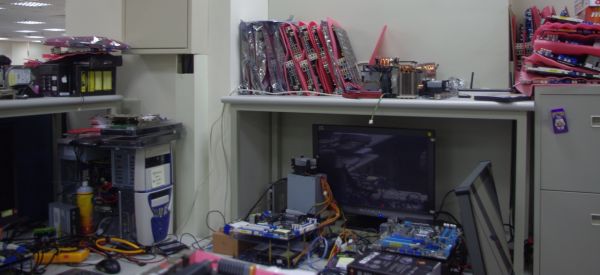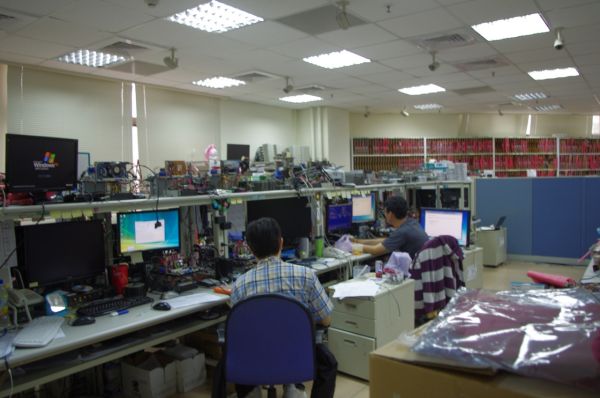Computex 2011: ASRock HQ Tour and Booth
by Ian Cutress on June 12, 2011 2:00 AM EST- Posted in
- Computex 2011
- ASRock
- Trade Shows
The visit to ASRock was more like I would expect when visiting such a place – I was only allowed to take pictures in certain areas, such as the main offices, but not in places such as the new product development, or regarding product testing. It was all fairly open plan – the design and testing employees were all within earshot of one another, or a short walk down the corridor.
The first thing that struck me was a wall of motherboards:
I was told that these are products for testing and future reference. As with any major manufacturer of any sort of business, knowing your competitors product is vital in predicting what will come out next and what your product needs to have the competitive edge. ASRock are no different: there were various other manufacturers products dotted over all the desks – particularly GPUs as ASRock do not currently make their own.
Testbeds were built using design PCBs with nothing attached, which is a good idea if you have plenty laying around. Whilst walking through, I had a sense that the engineering section, in terms of cleanliness, was less polished – lots of space was taken up with motherboards for testing or motherboards for shipping, and the filing system seemed to consist of ‘let’s stack this here or there’. Nevertheless, I did see people hard at work!
As part of the tour, I was introduced to the engineers in charge of the ASRock Intel and AMD platforms, as well as the Vice Presidents in charge of Research and Development. I spent most of my time talking to the engineer behind the designs of the Fatal1ty products – ASRock’s higher end platforms designed at gaming. We had a long chat based on what I feel various market segment needs, some of ASRock’s design philosophy, and how design should meet price targets but still be competitive. At one point it was suggested that we make a X79-IAN, however after chatting to the VP of Sales, I would also have to be in charge of marketing…!
Part of the areas in which I was not allowed to take pictures included some product testing – particularly with regards extreme temperature and humidity. There were three main units, each around six foot high and five foot wide, using a combination of heaters and liquid nitrogen to create environments below 0ºC and above 70ºC at a range of humidity, all the while looping various stability tests.
Last year, I was told by ASRock that over 8 million motherboard units were sold worldwide (compared to 20+ million by ASUS), with a revenue in excess of $300 million – not bad for a company with around 250 employees worldwide. I was constantly told that ASRock are continually looking to expand, but require the appropriate staff to do so.














17 Comments
View All Comments
7amood - Sunday, June 12, 2011 - link
The micro-ATX design is interesting... really... kept looking at it for some time there.Would love to see other manufacturers do the same.
I totally agree with you regarding the SATA ports.
AmineBouhafs - Sunday, June 12, 2011 - link
I really like the ASRock Z68 Extreme7!The ASRock Z68 Extreme4 was kind of "lacking" in features and performance (except for the USB) when compared to the Asus Maximus Extreme-Z but, the ASRock Z68 Extreme7 keeps ASRock back (and ahead if it was my choice) in the 1155-race.
The ASRock P67 Extreme6 was in danger with the stepping, so that was a no-go for me also.
Anybody got an idea when the ASRock Z68 Extreme7 will hit the market in Europe and especially Holland?
But FIVE PCIe x16 slots? I mean come'on, what the *** for?! Talk about overkill!
"so that if one GPU is used, the connectors bypass the NF200 chip so we don’t see the 2-3% decrease in performance that it brings"?
Oh please, just to make up 2-3% doesn't justify it for me, I'm sorry.
They could easily use the space for USEFULL hardware.
But, I'd really like a shot at that board!
JessusChristDoOTcom - Sunday, June 12, 2011 - link
<quote> But FIVE PCIe x16 slots? </quote>The more the merrier. If you start populating the board with PCIe cards like RAID, sound, TV card, etc. then it's all worth it. The fact that you can move your GPU card or cards to different locations of the board while shifting the other cards to other slots in order to maximize air flow or convenience of access just adds the icing to the cake.
<quote> They could easily use the space for USEFULL hardware. </quote>
WHAT hardware ARE you talking about? Every extra PCIe slot IS useful hardware. Every extra PCIe slot is precious. I am willing to incur 5% loss in performance in order to gain 2 additional PCIe slots for future add-ons--which is the useful hardware you are must be talking about.
Stuka87 - Sunday, June 12, 2011 - link
Having worked in an engineering environment (CATV RF & Fiber Optics), this is note entirely out of the ordinary. I am somewhat guilty at doing this as well. It typically comes down to time and work load. About once a month I would take some time and re-organize my area, as I did try to keep it clean and organized, it just didn't always happen.We also kept around competitors products. Was always interesting to see what manufacturers actually met the specs that they advertised. And sadly, it was only about half.
sprockkets - Sunday, June 12, 2011 - link
" Like the mini-ITX model, the SATA ports are angled into each other, which is a feature I don’t approve of. "Doesn't that make it easy to unlatch them? If they weren't, wouldn't you have to unlatch one to get to the other?
"There also doesn’t seem to be many fan-headers – I can see two around the socket and one on the bottom – personally, I’d prefer a lot more."
Two onboard fan headers for micro atx not good enough?
Goty - Sunday, June 12, 2011 - link
My thoughts exactly. Sound like the author got up on the wrong side of the bed before writing this article. Either that or he got snubbed by the receptionist during his visit and he's feeling vindictive.Taft12 - Monday, June 13, 2011 - link
Another "me too" post. Has there ever been a mATX board with more than 2 system fan headers?And keen observation about this being a smart way to lay out the SATA ports so that the latch side is facing out on both sides! Probably Ian didn't realize that either, perhaps an after-the-fact editor's note is in order?
IanCutress - Monday, June 13, 2011 - link
Aha OK I see where you're coming from. Regarding the SATA ports, for me, it's a case of fitting them in without having to directly look at them - do you ever have the situation where you try and plug in a USB device to a USB port, it doesn't go in first time, then you turn it around and it still doesn't go in, then you have to actually look for third time successful? With SATA connectors, that's how I feel if they're alternately rotated. It all depends on how often you decide to add/remove drives from your systems I guess, but everyone has or can have a different opinion so it seems.Regarding fan headers, my preference is always to be able to fit a Corsair H50 water cooler, and possibly other fans in the vicinity. So I need one header for the pump and two for the radiator fans in the socket area, then having a look at where the other headers are in relation to where fans might be in a case.
Ian
sprockkets - Monday, June 13, 2011 - link
OK, but I do that even if they are right cause you can't really tell which way latchless cables are oriented!jabber - Sunday, June 12, 2011 - link
....wasted on a logo that really isnt worth anything anymore.I refer of course to the THX one.
Not really a selling point IMO.